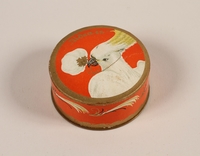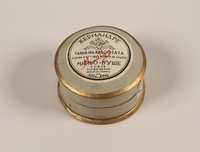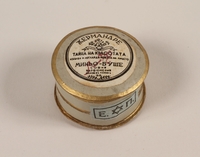Overview
- Brief Narrative
- Unused, Regina brand face powder with an art deco design and crown logo on the lid manufactured by K. A. Chavdarov in Sofia, Bulgaria, in approximately 1940. The powder color, Rachel, is stamped on the bottom in purple ink and references Eliza Rachel Felix (1821- 1858), a popular Jewish, French stage actress from the mid-1800s. She performed under the stage name Rachel, was well-known in Europe, Russia, and the United States as a beautiful, talented, and graceful performer. At the time, most proper woman did not wear cosmetics, but it was common practice for actresses, especially as stages were becoming better lit and their faces were more visible. Mass produced cosmetics were typically powder based and came in 3 colors, rose, white, and a darker crème color often associated with brunettes with dark coloring. This was likely the color used by the dark haired Rachel, and her name quickly became synonymous with the creamier powder color. At the end of the 1800s and into the 1900s, greasepaint with a numbered color system came to dominate stage cosmetics, while the older powder-based varieties and their original names became quite popular and were used by respectable women in all parts of society. During the first half of the 1900s, the spelling of Rachel began to vary, but was maintained as a color and eventually expanded to include a range of associated shades, with the number of tints peaking in the 1950s.
- Date
-
manufacture:
approximately 1940
- Geography
-
manufacture:
Sofia (Bulgaria)
- Credit Line
- United States Holocaust Memorial Museum Collection, Gift of Barbara Rein
- Markings
- lid exterior, top, logo, printed, orange ink : РЕГИНА [REGINA]
lid exterior, lower sides, printed, black ink : ЛУКСОЗНА ПУДРА РЕГИНА [LUXURY POWDER REGINA SELECT]
base exterior, bottom, around the rim, printed gold ink : ЛУКСОЗНА ТОАЛЕТН ПУДРА – РЕГИНА – К.А. ЧАВДАРОВЪ - СОФИЯ – РЕГИНА - [LUXURY TOILET POWDER – SELECT - REGINA – K. A. CHAVDAROV – SOFIA – REGINA]
base exterior, bottom, upper center, printed, black and red ink : ЛУКСОЗНА / ПУДРА / РЕГИНА (logo) / ЦВеТъ [LUXURY / POWDER / REGINA (logo) / COLOR] - Contributor
-
Manufacturer:
K. A. Chavdarov
Subject: Rachel Felix
- Biography
-
Eliza Rachel Félix was born on February 28, 1821, near Mumpf in the Swiss canton of Aargau, to Jacques and Thérèse-Esther-Chaya Félix. Her parents were itinerant Jewish peddlers of second-hand clothing. Eliza had 5 siblings: Sophie-Sarah, Raphaël, Rébecca, Adelaïde-Lia, and Mélanie-Dinah. The family lived in a wagon that also doubled as a storehouse for their goods. While performing on the streets of Lyon, France, Eliza Rachel and Sophie-Sarah were discovered by Etienne Choron, a Parisian musician and educator. He invited the girls to attend his school for musical and theatrical training, so their family settled in the Jewish quarter of Paris in 1831. During the 1830s, Eliza Rachel continued to receive private training as an actress and in 1838, she debuted at the Comédie Française under the name Rachel. Her performance was met with critical acclaim that praised her talent, technique, and passion as an actress. Her career grew steadily and focused on her skills at portraying classical French, historical, and patriotic characters. During the 1840s and early 1850s Rachel toured all over Europe, traveling from Great Britain to Moscow, Russia. In 1855 she went as far as the United States. She was widely known for her talent, but also for her grace and distinctive beauty. She was very close with her family, and supported the acting careers of her sisters. At different points in her career, both her father and brother served as her manager. She never married, but was known for having affairs with prominent and powerful men, and bore two illegitimate sons. She remained a member of the Jewish faith, but had her children baptized as Christians. On January 4, 1858, Rachel, aged 36, died of tuberculosis in Le Cannet, France. The Chief Rabbi of France, Lazard Isidor, presided over her funeral and she was buried in Paris.
Physical Details
- Language
- Bulgarian
- Classification
-
Containers
- Category
-
Boxes
- Object Type
-
Powder boxes (Cosmetics containers) (lcsh)
- Physical Description
- Circular, telescoping, cardboard box with a slightly domed lid. It is covered with paper. The design on top features an inverted white triangle dividing the circle into 3 sections; orange at the bottom and white at the top. Within the triangle is the logo of a gold crown above a black rectangle with Bulgarian Cyrillic text. There are gold colored borders on the slightly protruding upper and lower rims. Around the sides is a thick band of white, gold, and orange rectangles above a gold colored band printed with black Bulgarian Cyrillic text. Adhered to the base underside is circular, white paper label with a black floral border and a ring of Bulgarian Cyrillic text. At the center is the logo with a red crown, Bulgarian Cyrillic text, and a purple stamp. The box interior has a sealed powder drum and powder.
- Dimensions
- overall: Height: 0.875 inches (2.223 cm) | Diameter: 2.000 inches (5.08 cm)
- Materials
- overall : cardboard, paper, ink, adhesive, powder
- Inscription
- base exterior, bottom, lower center, stamped, purple ink : Rachel I [partially legible]
Rights & Restrictions
- Conditions on Access
- No restrictions on access
- Conditions on Use
- No restrictions on use
Keywords & Subjects
Administrative Notes
- Legal Status
- Permanent Collection
- Provenance
- The face powder container was donated to the United States Holocaust Memorial Museum in 2004 by Barbara Rein.
- Funding Note
- The cataloging of this artifact has been supported by a grant from the Conference on Jewish Material Claims Against Germany.
- Record last modified:
- 2022-08-17 12:13:13
- This page:
- https://collections.ushmm.org/search/catalog/irn515244
Download & Licensing
In-Person Research
- By Appointment
- Request 21 Days in Advance of Visit
- Plan a Research Visit
- Request to See This Object
Contact Us
Also in Barbara Rein collection
The collection consists of four face powder containers marked with the color name Rachel sold in Bulgaria before and during the Holocaust, including the period when Bulgaria was an Axis ally.
Date: 1916-approximately 1943

Ideal face powder box with a cockatoo design marked Rachel
Object
Unused, Ideal brand face powder with a cockatoo on the lid manufactured in the large Nikola Chilova chemical plant in Kostinbrod, Bulgaria, between the 1920s and the 1940s. The powder color, Rachel, is stamped on the bottom and references Eliza Rachel Felix (1821- 1858), a popular Jewish, French stage actress from the mid-1800s. She performed under the stage name Rachel and was well-known as a beautiful, talented, and graceful performer. At the time, most proper woman did not wear cosmetics, but it was common practice for actresses, especially as stages were becoming better lit and their faces were more visible. Mass produced cosmetics were typically powder based and came in 3 colors, rose, white, and a darker crème color often associated with brunettes with dark coloring. This was likely the color used by the dark haired Rachel, and her name quickly became synonymous with the creamier powder color. At the end of the 1800s and into the 1900s, greasepaint with a numbered color system came to dominate stage cosmetics, while the older powder-based varieties and their original names became quite popular and were used by respectable women in all parts of society. During the first half of the 1900s, the spelling of Rachel began to vary, but was maintained as a color and eventually expanded to include a range of associated shades, with the number of tints peaking in the 1950s.

Mignot-Boucher face powder box marked Rachel with an excise label
Object
Unused, Germandrée brand face powder with a tax stamp manufactured by Mignot-Boucher in Sofia, Bulgaria, between 1916 and 1943. Mignot-Boucher was a French company founded in 1818, and bought in 1916, by the Jewish Bulgarian Arié family. The company became a driving economic force, growing the family’s prestige and wealth as it improved the nation’s manufacturing power. In 1941, Bulgaria joined the Axis alliance and increased the systematic persecution of Jews, including an official boycott of Jewish goods. In 1943, the owners of the company were arrested under the pretense of stealing from the state. The arrest was driven by anti-Semitism, and once they were hanged for their false crimes the company passed into Bulgarian control. The powder color, Rachel, is stamped on the bottom and likely references Eliza Rachel Felix (1821- 1858), a popular Jewish, French stage actress from the mid-1800s who performed under the stage name Rachel. At the time, most proper woman did not wear cosmetics, but it was common practice for actresses. Mass produced cosmetics were typically powder based and came in 3 colors, rose, white, and a darker crème color. This was likely the color used by the dark haired Rachel, and her name quickly became synonymous with the creamier powder color. At the end of the 1800s, theatrical cosmetics became popular and were used by respectable women in all parts of society. During the first half of the 1900s, Rachel was maintained as a color and eventually expanded to include a range of associated shades.

Mignot-Boucher face powder box marked Rachel with a Star of David label
Object
Unused, Germandrée brand face powder with a Jewish product stamp manufactured by Mignot-Boucher in Sofia, Bulgaria, between 1942 and 1943. Mignot-Boucher was a French company founded in 1818, and bought in 1916, by the Jewish Bulgarian Arié family. The company became a driving economic force, growing the family’s prestige and wealth as it improved the nation’s manufacturing power. In 1941, Bulgaria joined the Axis alliance and increased the systematic persecution of Jews, including an official boycott of Jewish goods. In 1942, stamps indicating that an item was a Jewish product were added to merchandise like the powder. In 1943, the owners of the company were arrested under the pretense of stealing from the state. The arrest was driven by anti-Semitism, and once they were hanged for their false crimes the company passed into Bulgarian control. The powder color, Rachel, is stamped on the bottom and likely references Eliza Rachel Felix (1821- 1858), a popular Jewish, French stage actress from the mid-1800s who performed under the stage name Rachel. At the time, most proper woman did not wear cosmetics, but it was common practice for actresses. Mass produced cosmetics came in 3 colors, rose, white, and a darker crème color. This was likely the color used by the dark haired Rachel, and her name quickly became synonymous with the creamier powder color. At the end of the 1800s, theatrical cosmetics became popular and were used by respectable women in all parts of society. During the first half of the 1900s, Rachel was maintained as a color and eventually expanded to include a range of associated shades.



